“International Shibori Symposium 2018 Review (Part I)” by Astrid Bennett & Kim Eichler-Messmer
August 6, 2018
Held earlier this summer, the 11th International Shibori Symposium (11ISS) was an exciting and densely-packed exploration of the dyeing traditions of Japan. 125 participants came from international countries, with another equal number from Japan. The schedule included workshops and events in the shibori village of Arimatsu; the safflower harvest, other natural dye and sashiko workshops in the Yamagata region of northern Japan; plus contemporary shibori exhibitions, workshops and studio visits in Nagoya and Tokyo. With the scope of the itinerary, participants could choose to attend the full symposium, or either the first or second half. Astrid Bennett was able to attend the Inland Sea Tour and the first half of the Symposium and report on those in Part I of II blog articles covering the 11ISS. Kim Eichler-Messmer attended the full Symposium and reports in Part II on the Yamagata portion of the Symposium.
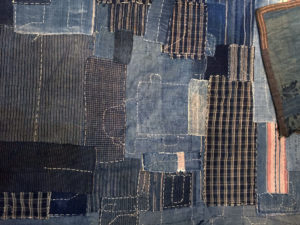
These boro garments were from cold, northern Japan, where residents were not permitted to wear cotton or silk. Clothing was made of scratchy hemp. Jackets were padded with hemp as well to try to keep out the cold.
11ISS co-coordinator Yoshiko Wada worked tirelessly to make sure that her international guests had an authentic and high quality experience of Japan. She introduced us to important rituals of greeting and leaving hosts, of entering a Shinto or Buddhist shrine, and of navigating the train system. For me, this trip was a wonderful balance of traditional textiles with contemporary art and architecture as seen from an eastern perspective. And not to forget: the food and the art of food presentation!
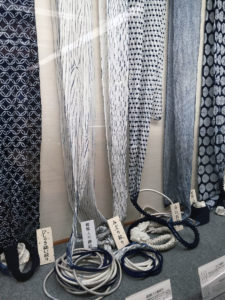
Examples of traditional and historical shibori in Tamesaburo Furokawa Memorial Hall, Arimatsu.
The Symposium officially started with a reception of the stunning Takeda Collection of Kimono in its headquarters in Narumi. The next two days, all participants traveled the 30 minutes to Arimatsu by train, exploring this historic center for shibori production, attending 3-hour workshops on a variety of topics, along with shopping and dining. Arimatsu is home to shibori practitioners still in production, with approaches to shibori and clothing designs ranging from traditional to more contemporary. Many use indigo and other natural dyes; others use chemical dyes.
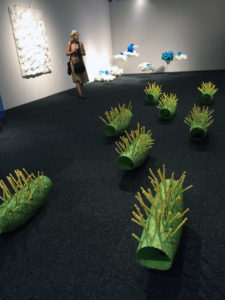
Exhibition installation, Shibori: Fusion + Diffusion, the 11ISS-organized contemporary shibori exhibition at Tama Art University Museum. Shown, left to right: Tanaka Takaaki; Nagai HItomi; and Iyanaga Yasuko.
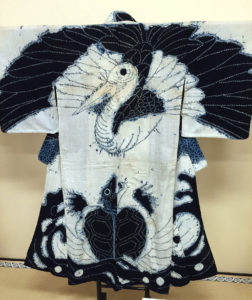
The spectacular exhibition at Nagoya Castle of Arimatsu-Narumi Shibori.
Many full and half day workshops were offered. My first was Kaki-shibu (Persimmon Tannin) shibori dyeing with master dyer Kaiichiro Okamoto. I wanted to explore its use for paper and fabric as a natural alternative to polymer medium. I also studied Itajime (clamped board resist) Shibori with Masatsugu Hamajima. This technique is one I was already familiar with but it was interesting to see the more complex wooden clamps and how they were made. This family had supplied dyed indigo shibori to Africa after World War II under the Marshall Plan. In addition to the war, shibori villages had also been affected by changes in the Japanese feudal system, which had traditionally mandated more infusion of funds into local villages than what came later. In Arimatsu, dyers developed shortcuts and technological improvements to make the process faster and more consistent. Recently, the shibori district was awarded a protected, historic status.
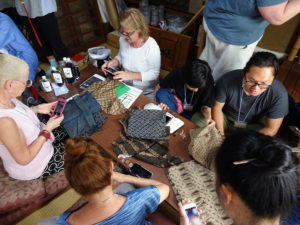
Checking out samples in the Kaki-shibu (Persimmon Tannin) shibori dyeing with master dyer Kaiichiro Okamoto. We all sat on traditional floor cushions.
Symposium Day 3 consisted of lectures and presentations in Nagoya. Among many, notable to me was Jian Liu’s discussion of analysis of natural dye identifications in Qing Dynasty Silks. New technology is allowing for exciting discoveries of dye colors in historic textiles, from Safflower, Sappan wood, Indigo, Pagoda tree, Amur Cork, young Fustic and Turmeric dye sources; their research is creating a Japanese dye database. As a side note, prehistoric textiles from 500 BC were the first to use resist dye techniques, and the first Biennale of Natural Dyes will take place in China in 2019.
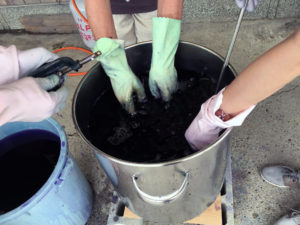
Dip dyeing resisted silk in two different dye baths, in our Itajime workshop with Masatsugu Hamajima.
At the Nagoya City Museum, Shibori Master Hayakawa Kaei demonstrated how he creates arashi shibori using updated, automated tools. He is another example of someone who attended art school in painting and returned to become the master dyer in his family, dyers for generations. Finally, we visited the Furukawa Museum, located in a beautiful Japanese home, displaying fragments of ancient fabrics. Some of us attended a lecture on and showing of a 1630 book displaying textile patterns that included both dyeing and embroidery.
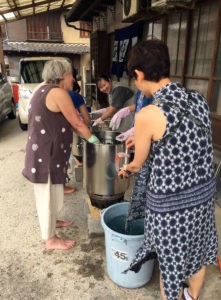
Participants dip dyeing resisted silk scarves in two different dye baths, in our Itajime workshop with Masatsugu Hamajima.
Next day, we traveled via bullet train and bus to Tokyo, making a stop at Shibori: Fusion + Diffusion, the 11ISS-organized contemporary shibori exhibition and reception at Tama Art University Museum. This was a stellar show of contemporary work featuring primarily Asian artists, but also work by Westerners. There we also had lively mini-presentations, “Pecha-Kucha” style, by selected attendees.
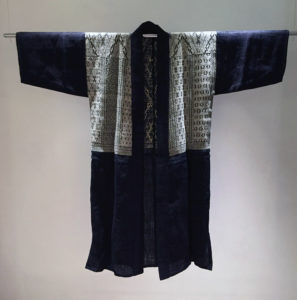
Boro textiles in the Amuse Museum in Tokyo. These looked like handwoven brocades but the white is stitchwork to reinforce older garments.
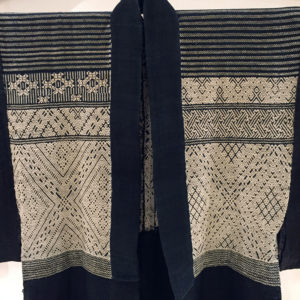
Boro textiles in the Amuse Museum in Tokyo. These looked like handwoven brocades but the white is stitchwork to reinforce older garments.
Our day in Tokyo allowed for individual exploration of exhibitions and shopping opportunities. Our group started with the Amuse Museum, where we viewed stunning Boro textiles from an impoverished area in northern Japan. We also visited PIGMENT, with pigments, brushes and more in a beautifully articulated setting; NUNO fabrics and stores for Issey Miyaki and other contemporary designers.
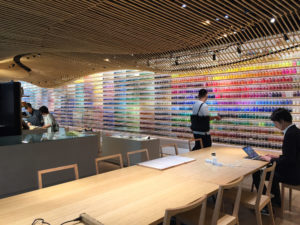
Tokyo had various shopping opportunities, including PIGMENT, which sells a vast spectrum of pigments and brushes in an architecturally inspiring space.
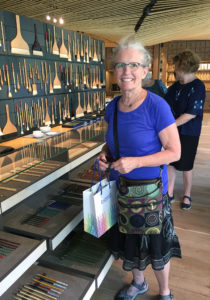
Astrid in PIGMENT, which sells a vast spectrum of pigments and brushes in an architecturally inspiring space.

5 Comments
Darcy Berg says
August 6, 2018 at 10:16 am
Excellent! Looks like a great time. Thanks for sharing.
Pat Bishop says
August 6, 2018 at 4:58 pm
Looks like an amazing experience!
Jane Suffield says
August 26, 2018 at 12:12 am
So inspirational - I wish I could have been there too.
Mary McFerran says
August 30, 2018 at 3:19 pm
This sounds like a wonderful tour. Will it be offered agian in 2019? Thanks, Mary
Lauren Sinner says
September 19, 2018 at 2:45 pm
Hello Mary, Yes the iss is offered every year in a different city / country. Click the link in the article for their website and more information.
Related Blog Articles
11iss
“International Shibori Symposium 2018 Review (Part II)” by Astrid Bennett & Kim Eichler-Messmer